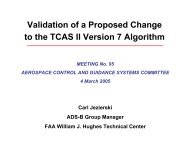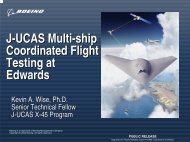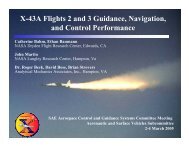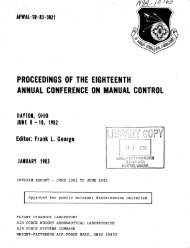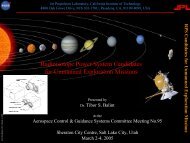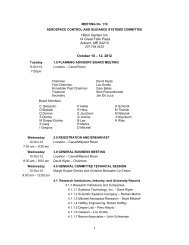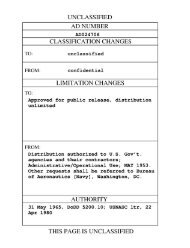Report of the Second Piloted Aircraft Flight Control System - Acgsc.org
Report of the Second Piloted Aircraft Flight Control System - Acgsc.org
Report of the Second Piloted Aircraft Flight Control System - Acgsc.org
Create successful ePaper yourself
Turn your PDF publications into a flip-book with our unique Google optimized e-Paper software.
The hydraulic system itself is a high-gain feedback ayetern. The<br />
load parameters <strong>of</strong> <strong>the</strong> hydraulic qystem are <strong>the</strong> effective mass <strong>of</strong>' <strong>the</strong><br />
elevators, <strong>the</strong> aerodynamic spring rate and <strong>the</strong> damping, both <strong>the</strong> aeromeal<br />
damping and that associated with <strong>the</strong> =in power piston, In<br />
addition, <strong>the</strong> compressibility <strong>of</strong> <strong>the</strong> oil acts essentiallg in shunt with<br />
<strong>the</strong> main load, since <strong>the</strong> flow <strong>of</strong> oil can go ei<strong>the</strong>r into compression <strong>of</strong><br />
<strong>the</strong> oil or into motion <strong>of</strong> <strong>the</strong> main piston and control surface. Up to<br />
reasonably high frequencies, typically in <strong>the</strong> order <strong>of</strong> magnitude <strong>of</strong> 15<br />
cps or above, <strong>the</strong> open-loop hydraulic system integrates, or, if we look<br />
at it from <strong>the</strong> frequencp-response standpoint, <strong>the</strong> gain drops <strong>of</strong>f inversely<br />
proportional to frequancy, Aa we reach <strong>the</strong> frequency at which resonance<br />
oocure between <strong>the</strong> oil compressibiUty and <strong>the</strong> load, <strong>the</strong> output tando to<br />
inorease. In o<strong>the</strong>r words, in this b a <strong>of</strong> frequencies <strong>the</strong> a<strong>of</strong>npre5aibUty<br />
effeat is such that it tends to increase <strong>the</strong> motion <strong>of</strong> <strong>the</strong> main piaton.<br />
When <strong>the</strong> main piston is moving to <strong>the</strong> right, for example, <strong>the</strong> oil in <strong>the</strong><br />
left cylinder is expanding, tending to give <strong>the</strong> piston motion an extra push.<br />
This resonance phenomena is very lightly damped due to <strong>the</strong> low frictional<br />
losses in <strong>the</strong> systam. When <strong>the</strong> hydraulic loop is closed, through <strong>the</strong><br />
input -age, <strong>the</strong> system will ordinarily oscUte with an amplitude<br />
driving <strong>the</strong> system into <strong>the</strong> nonlinear region <strong>of</strong> oscillation. In certain<br />
cases, <strong>the</strong>se nonlinearities, inherently preaeat in <strong>the</strong> system, or <strong>the</strong><br />
frictional losses which we have neglected tend to stabilize <strong>the</strong> wetem,<br />
but <strong>the</strong> relative stability is poor.<br />
Thie resonance phenomena, and <strong>the</strong> consequent instability or poor<br />
relative stability occurs at such a hi* frequency compared to <strong>the</strong> siepificant<br />
frequencies <strong>of</strong> <strong>the</strong> remainder <strong>of</strong> <strong>the</strong> overall aerodynamical systcrm,<br />
it doe6 not appear troublesome on <strong>the</strong> surface. The main difficulties arise<br />
because <strong>the</strong>se frequencies are, however, <strong>of</strong> <strong>the</strong> same order <strong>of</strong> magnitude as<br />
<strong>the</strong> flutter frequencies <strong>of</strong> <strong>the</strong> aircraft. The coupling between <strong>the</strong> flutter<br />
system and <strong>the</strong> Wdraulic and control system may cause undesirable amgUfication<br />
<strong>of</strong> <strong>the</strong> flutter amplitudes.<br />
This coupling between <strong>the</strong> unstable hydraulic system and <strong>the</strong> flatter<br />
system and <strong>the</strong> resulting tendency to increase flutter troubles can be<br />
circuw~ted in ei<strong>the</strong>r <strong>of</strong> two ways. First, we might simply cut <strong>of</strong>f <strong>the</strong><br />
Wdraulic wstem at a frequency mch lower than <strong>the</strong> band <strong>of</strong> frequencies <strong>of</strong><br />
significance 'in flutter phenomena. Seconily, w mi@t try to increase <strong>the</strong><br />
relative stability <strong>of</strong> <strong>the</strong> hydraulic system while maintaining <strong>the</strong> high lowfrequency<br />
gain. The first solution is certainly <strong>the</strong> simpler. The principal<br />
disadvantage <strong>of</strong> this method <strong>of</strong> cutting <strong>of</strong>f <strong>the</strong> wdraulic system at low<br />
frequencies is <strong>the</strong> resultant sluggiah response <strong>of</strong> <strong>the</strong> overall aircraft<br />
system, or even <strong>of</strong> <strong>the</strong> wstem from <strong>the</strong> stick to <strong>the</strong> control cnrrface. This<br />
relationship betwema <strong>the</strong> bandwidth and <strong>the</strong> tims de4 or time <strong>of</strong> <strong>the</strong> transient<br />
response is nothing quantitative, but in general it can be said that, if <strong>the</strong><br />
aystem is suitably damped so that <strong>the</strong>re is not undesirable overshoot in <strong>the</strong><br />
transient response, <strong>the</strong> time required for <strong>the</strong> wstem to respond to a step<br />
function input and essentially reach <strong>the</strong> steady state is inversely proportid<br />
to <strong>the</strong> bandwidth. In particular, if <strong>the</strong> bandwidth is one cps, as an example,<br />
<strong>the</strong> system will respond to a transient input in something like one-half to one



